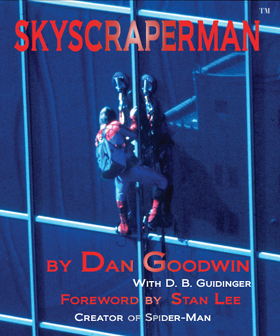
About: Skyscraper Defense Press
Spider Dan looks back (and up) at
his skyscraper-scaling exploits.
By Rod O’Connor Illustration by Gilbert Ford
Back when Tobey Maguire was still sporting Spider-Man Underoos, Dan
“Spider Dan” Goodwin was bugging city bureaucrats with his real-life
superhero impersonations.
In 1981, Goodwin successfully scaled the 1,454-foot-high Sears Tower.
His costumed stunts made him a minor celebrity—and raised the ire of
then–fire commissioner William Blair, who ordered firefighters to blast
Goodwin with water during his follow-up climb of the John Hancock Center.
But Goodwin had a reason for his death-defying feats: Two decades before
September 11, he climbed to call attention to the need for new ways
to rescue people from high-rise fires.
After the Twin Towers fell, Goodwin started a company called Skyscraper
Defense to create SWAT-like squads trained in high-rise rescues using
buildings’ exteriors. We caught up with the former “Spider Dan,” now
51, in Marin County, California, where he works as a construction contractor,
and asked him what it was like to get seriously, ridiculously high.
You have a lot of pseudonyms: Spider Dan, SkyscraperMan. Which one do
you prefer?
I prefer SkyscraperMan. But Spider-Man the character is something that’s
always been with me.
Do you remember the first time you got high?
Got high…meaning what, exactly?
Meaning when you first got into climbing, of course. Rock climbing was
my thing way before buildings. I climbed outside Las Vegas in Red Rock
Canyon; Yosemite was a playground of mine for a while. But when I witnessed
the [1980] MGM Hotel fire in Las Vegas [where 84 people died], that’s
where it all started for me. I attempted to get some of the fire chiefs
there to use the techniques we would use in the mountains, and one of
them said, “Have you ever climbed one of these buildings?” And I said
no, and he said, “Until you do, don’t tell me how to rescue people in
a high-rise.” That really stuck with me.
How’d you actually climb the buildings?
On the Sears Tower I was using suction cups and a camming device [a
spring-loaded climbing tool] inside the window-washing track. And that
was very precarious. And on the John Hancock building I used a camming
device that went on the I-beam itself, but it wasn’t really solid. If
I hit anything weird in any way, it could rattle off. So when [former
Fire Commissioner] Blair was spraying me with water, he didn’t realize—well
actually, I think he did realize, because I think that was his intention
to knock me off. What a lot of people don’t realize is that after the
Sears Tower he told me if I ever climbed another building in the city
again, he would kill me. And I responded by: “Well, then, I’ll give
you a call.” And I did, I called him that morning before the John Hancock.
And he just went ballistic. And that’s why he started smashing out windows
and spraying me with a fire hose. He was going to do whatever it took
to stop me.
What was the last building you scaled?
The CN Tower in Toronto back in 1986.
Do you ever walk by a building and think, I could climb that. Yeah,
I do. I would love to just walk around and climb any building that I
want to climb. But unfortunately, we’re living in a different era now
with the threat of terrorism and everything else. And since I’m trying
to change how we rescue people in high-rise buildings, I’m not so sure
that would benefit the cause.
Would you come out of retirement to climb Trump’s new building? Actually,
as a climber, I’m better now than I was before. But as far as doing
it illegally, I don’t need to do that. [Laughs] But if Donald Trump
wanted me to, it would be a blast.
Did you ever consider “getting high” before, uh, getting high? You wouldn’t
get behind the wheel of a race car and get high before that. The same
holds true with climbing.
Your company Skyscraper Defense is pushing for a congressional bill
to train superelite rescue teams that can help save people from burning
skyscrapers, or the next September 11. Are you just creating a job for
yourself?
No, I wouldn’t say it’s a way of creating a job for myself. I’ve been
in contact with some of the world’s best climbers. Once I have that
team defined, we’re going to pick a couple cities that are going to
invite us to work with high-rises and start developing and refining
the actual [rescue] techniques…. My goal is to leave something behind;
maybe history will look back and show I helped get the Skyscraper Defense
Act passed. When I’m 80 years old, that would be so cool to look back
on. For me, that would be even cooler than climbing the buildings.



